Photo gallery Moments in Time 2020: A Year of Resilience
Say what you will about the year 2020 but, punishing as it may have been, it was filled with examples of resilience. Hopes were realized with the development of coronavirus tests, treatments and vaccines. Protests led to an overdue (though unfinished) reckoning over racial justice. Technology helped us bridge distances. And democracy itself, severely tested, prevailed. This is not to say that gain outweighed pain in 2020 — indeed, there will be lasting damage and loss — only that we found ways to persevere. University Communications photographers compiled a visual record of the year as it unfolded on campus. These are their most memorable Moments in Time.
Photographs by Jeff Miller, Bryce Richter and Brian Huynh; Text by Bill Graf
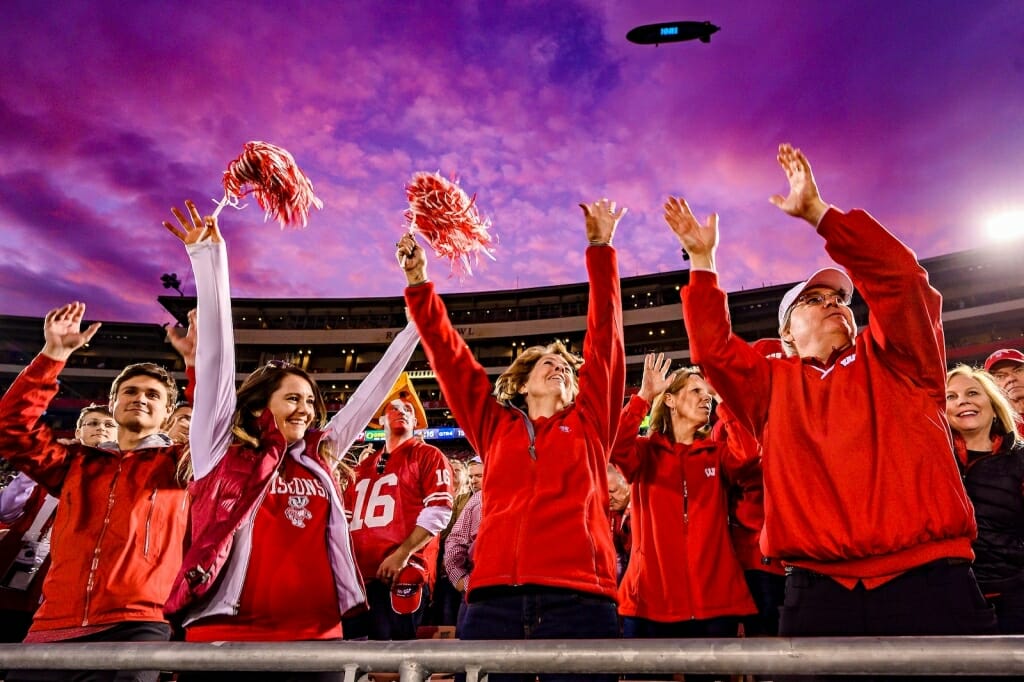
Traveling Badger football fans cheer the team on during the Rose Bowl in Pasadena, California, on Jan. 1. The Oregon Ducks defeated Wisconsin, 28-27. In retrospect, even losing the big game would pale in comparison to what else the year had in store. Photo by: Bryce Richter
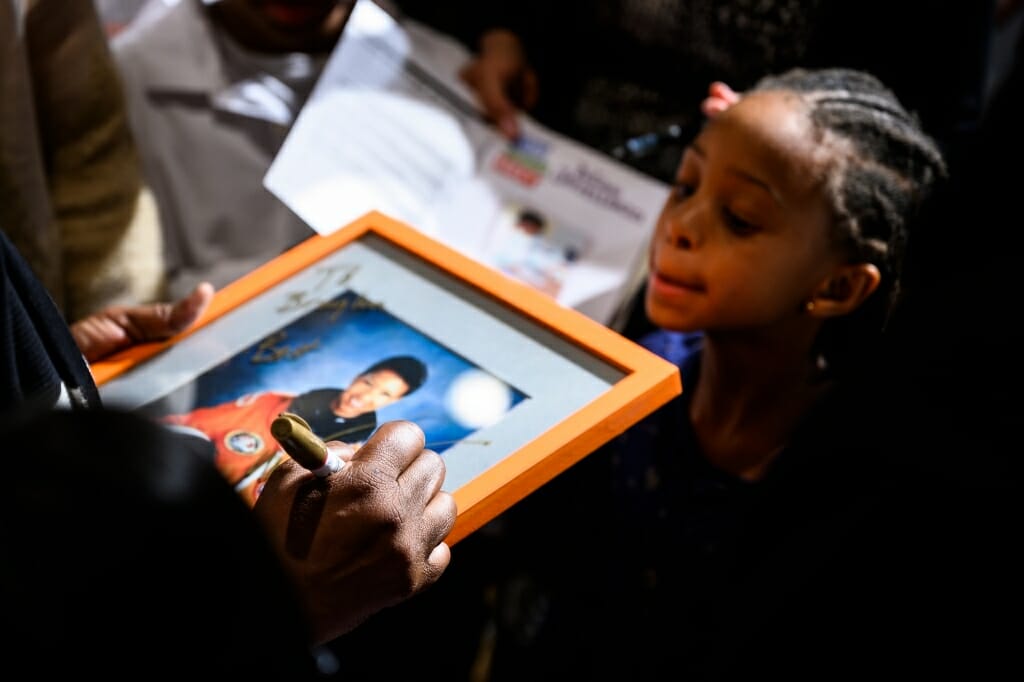
Perhaps seeing stars in her future, Shelby Boatwright, 6, watches as astronaut Mae Jemison, the first woman of color in space, autographs a framed photo. Jemison presented the Martin Luther King Jr. Memorial Lecture at Union South on Jan. 21. Photo by: Jeff Miller

In one of the year's most heartwarming but ultimately heartbreaking stories, Scout, a 7-year-old golden retriever, appears on Jan. 28 with his owner, WeatherTech CEO David MacNeil, and Dean Mark Markel, Chancellor Rebecca Blank and oncologist David Vail at the UW School of Veterinary Medicine. MacNeil sponsored a Super Bowl ad to raise funds and thank the school for its care of Scout, who had a rare form of canine cancer. Sadly, the TV commercial's "Lucky Dog" passed away in March. Photo by: Bryce Richter
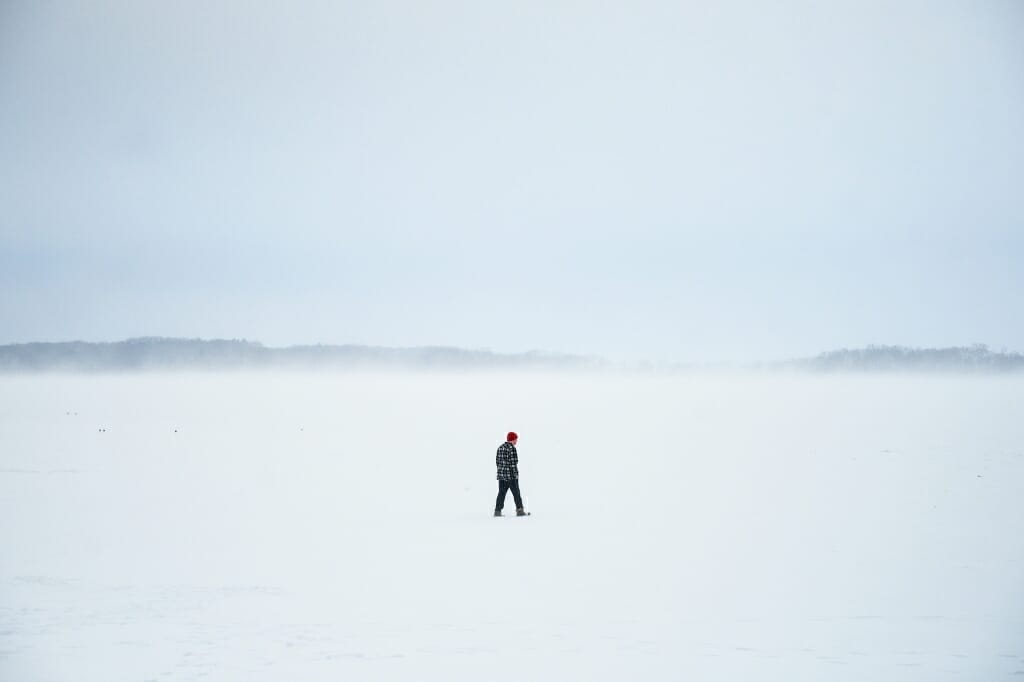
As if bracing for a confrontation with brutal days ahead, a lone hiker braves snow and cold to cross a frozen Lake Mendota near the Memorial Union. In the background is Picnic Point. Photo by: Brian Huynh
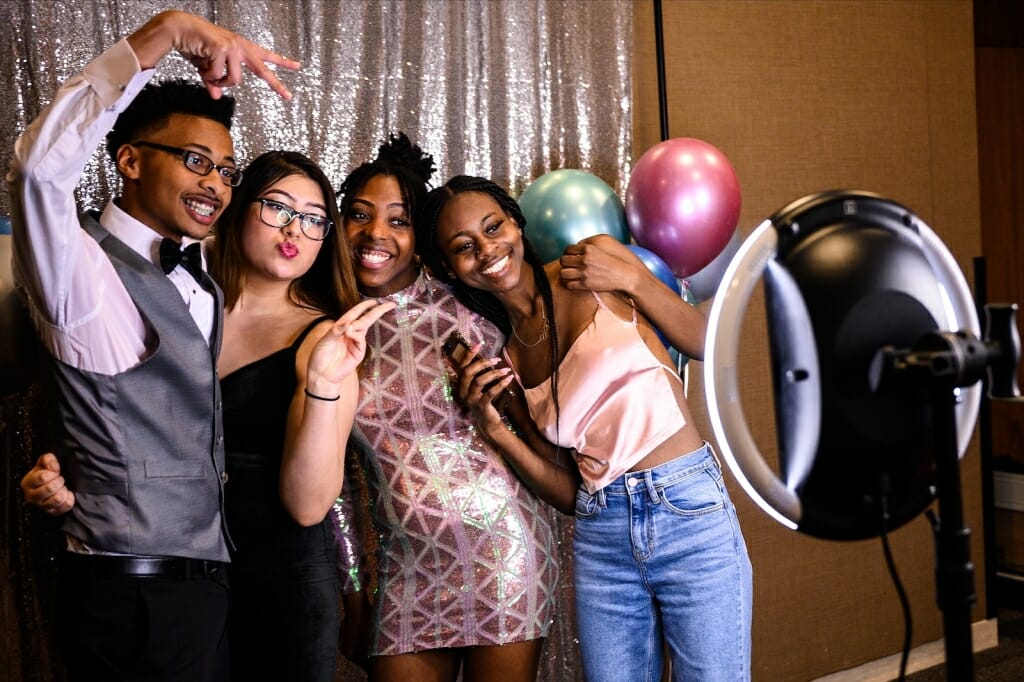
In a spirited kickoff to Black History Month events on campus, Isaiah Gordon, Jocelyn Orozco, Dianna Murray and Jaylah Batemon (left to right) pose at “An Afrofuturist Affair” at the Pyle Center on Feb. 7. The evening included dinner, music and a photo booth. Photo by: Jeff Miller
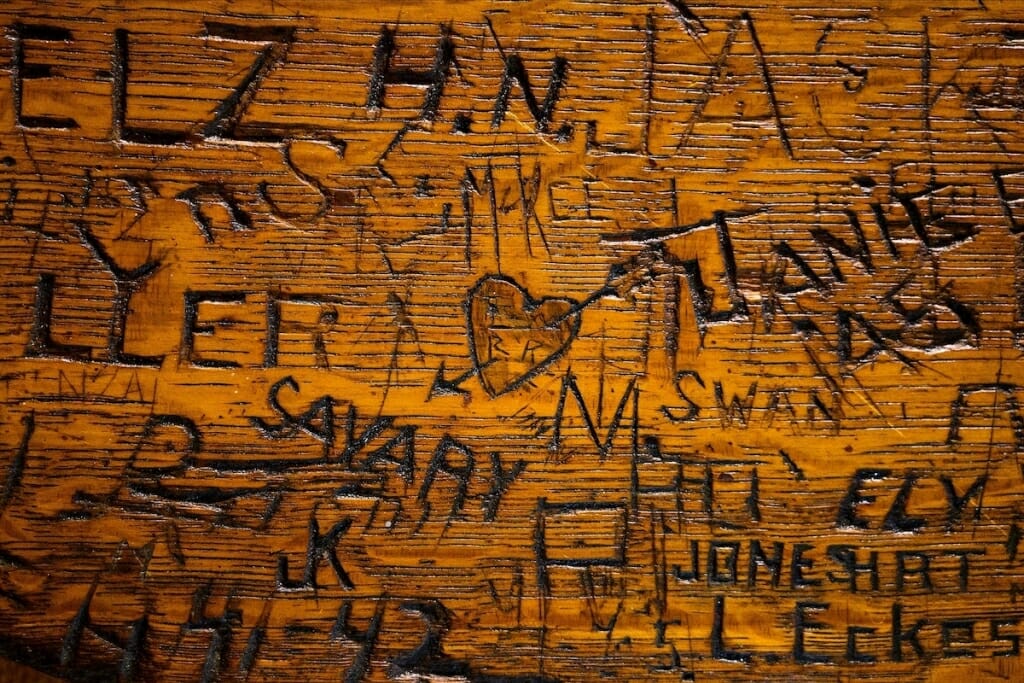
Sentiments and scribbles from the past survive on a wooden tabletop, carved years ago by students long gone, in the Memorial Union's Der Rathskeller. Today's guests are politely requested to send a text instead. Photo by: Brian Huynh
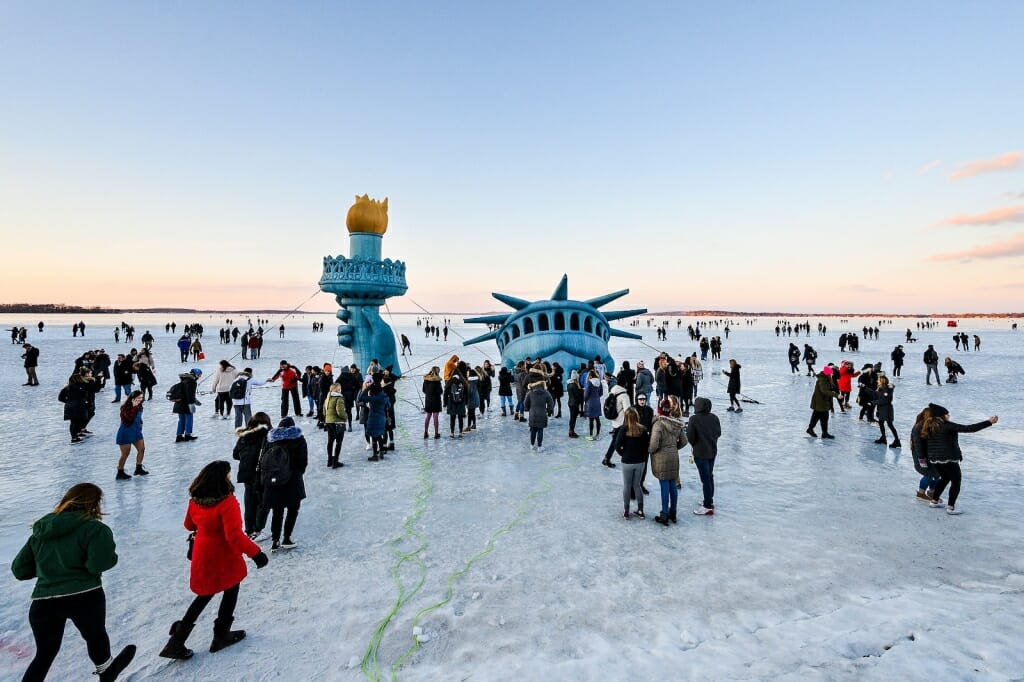
In homage to one of UW–Madison students' most memorable — and photogenic — stunts, visitors pose for pictures with an inflatable replica of the Statue of Liberty on Lake Mendota near the Memorial Union Terrace on Feb. 8. The display, based on an original installation from the 1970s, is part of the annual Wisconsin Union Winter Carnival. Photo by: Brian Huynh
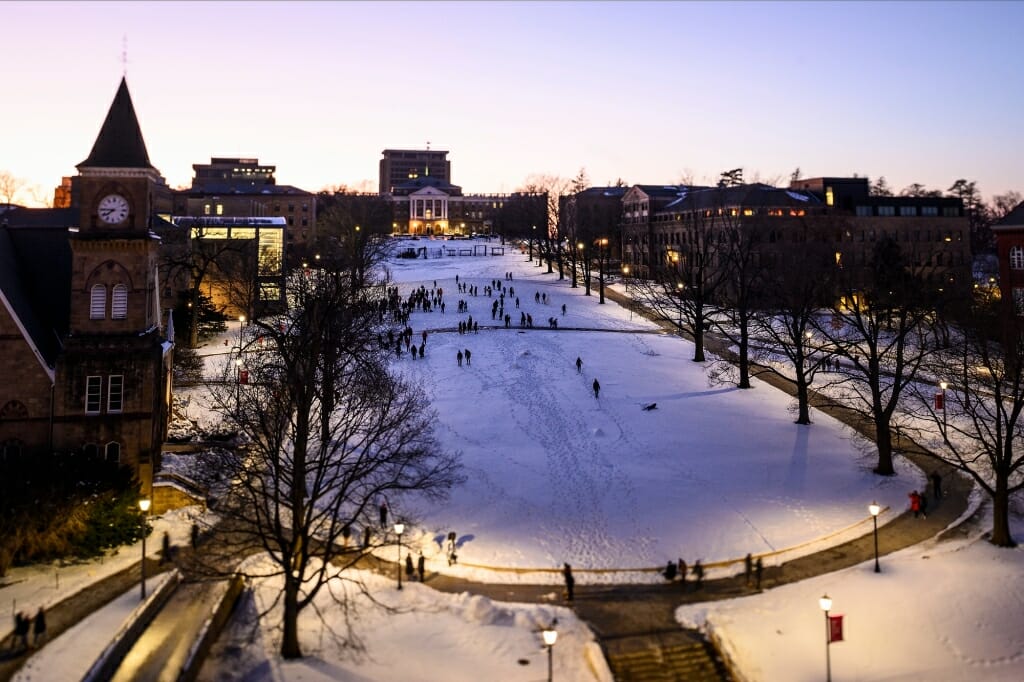
Chilled to the bone but invigorated by frosty fun, students disperse from Bascom Hill after waging the "Battle for Bottom of Bascom," an epic snowball fight staged on Feb. 15 between competitors from the Lakeshore and Southeast residence halls. This view is from the roof of the Mosse Humanities Building. Photo by: Jeff Miller
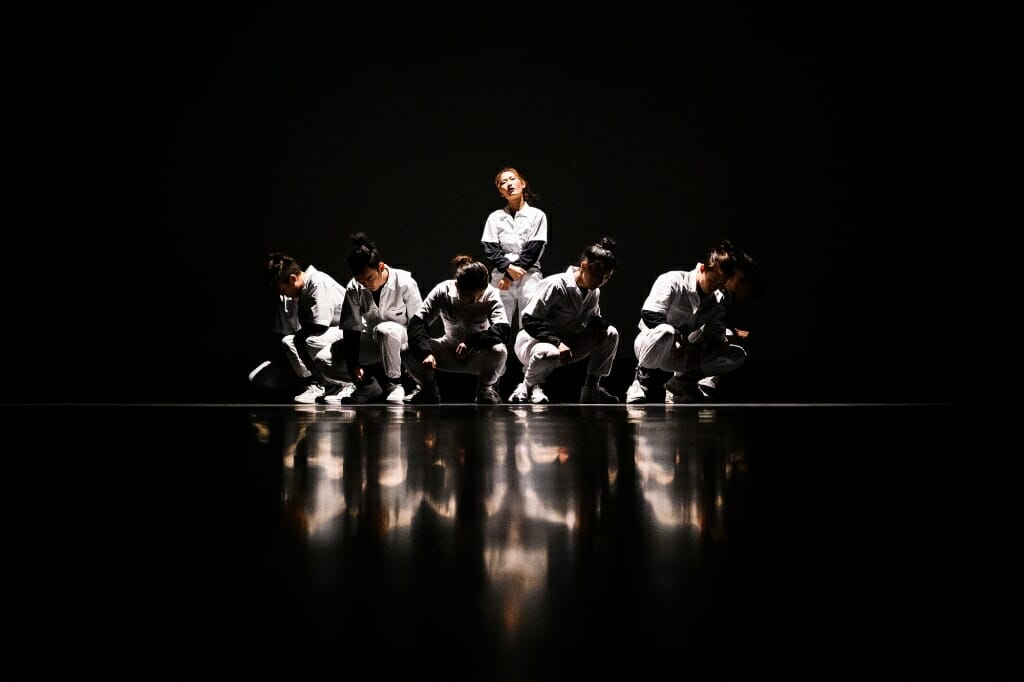
Student members of the UKAN Asian Hiphop Dance Crew from Ohio State University perform during the Chinese Undergraduate Student Association "Show Me Your Dance" at the Wisconsin Union Theater on Feb. 22. The event also featured dancers from Madacom, a Madison dance community comprising three UW organizations: Dancas Dance Crew, Korean & American Student Performers (KASPer), and Hypnotiq: Hip Hop Dance Crew. Photo by: Brian Huynh
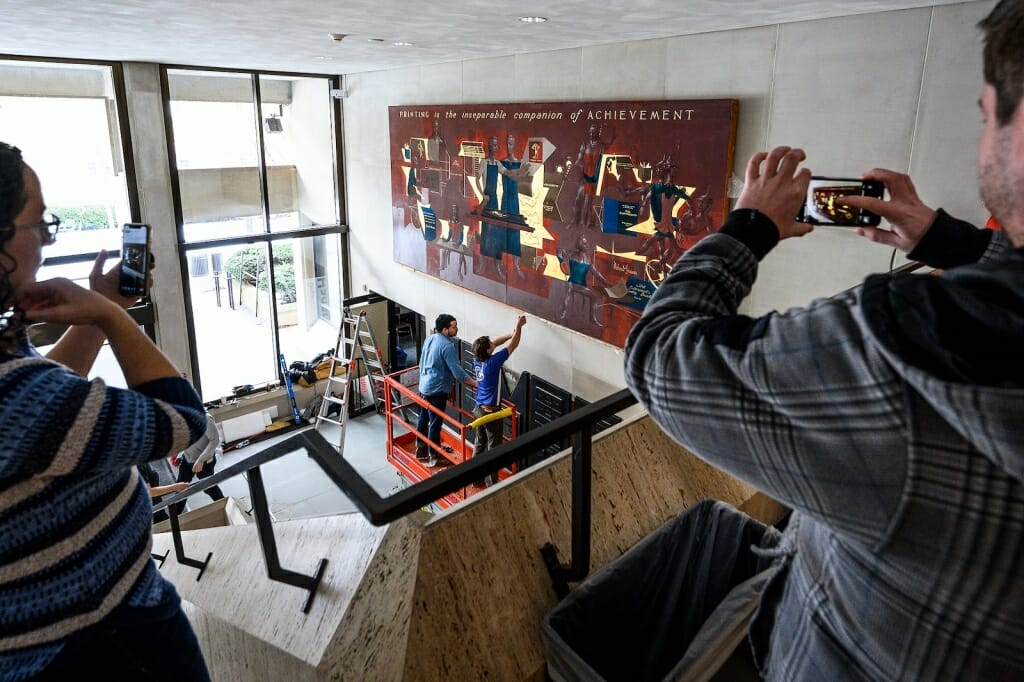
Before there was the web, there was Webcrafters. The owner of the Madison printing company donated “Printing is the Inseparable Companion of Achievement," a 1951 mural by former UW–Madison Professor James Watrous, to the Chazen Museum of Art. Visitors watch as the 18-foot-long, 500-pound artwork is hung in the museum's Elvehjem Building on Feb. 27. Photo by: Jeff Miller
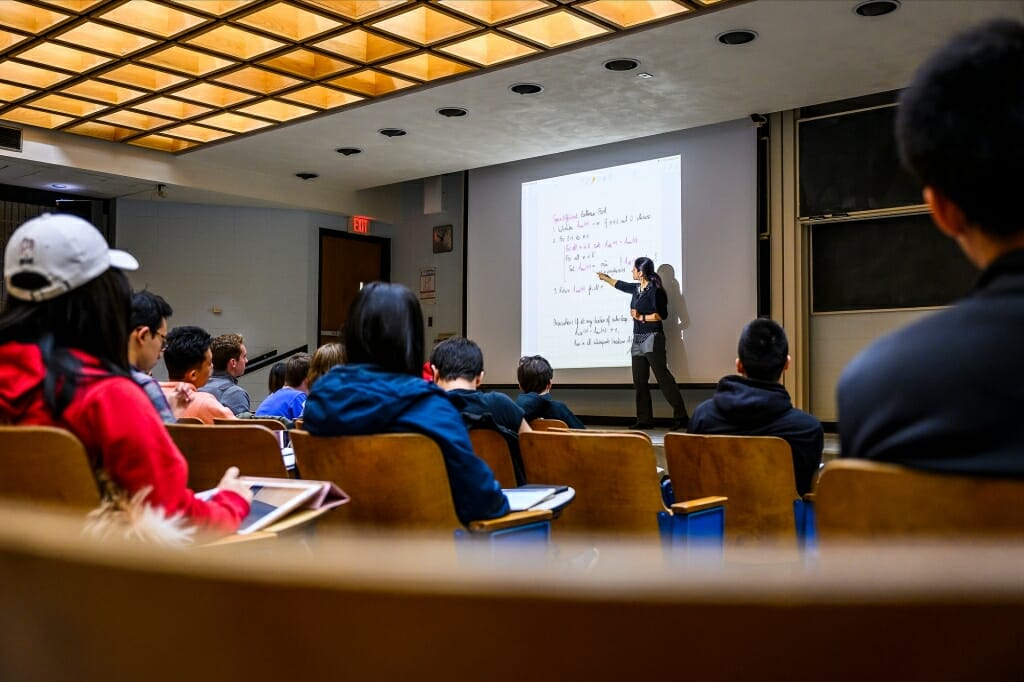
Just days before in-person classes are suspended due to COVID-19, Shuchi Chawla, professor of computer sciences, teaches an Introduction to Algorithms class in Noland Hall on March 5. Chawla is one of 13 recipients of the 2020 Distinguished Teaching Award. Photo by: Jeff Miller
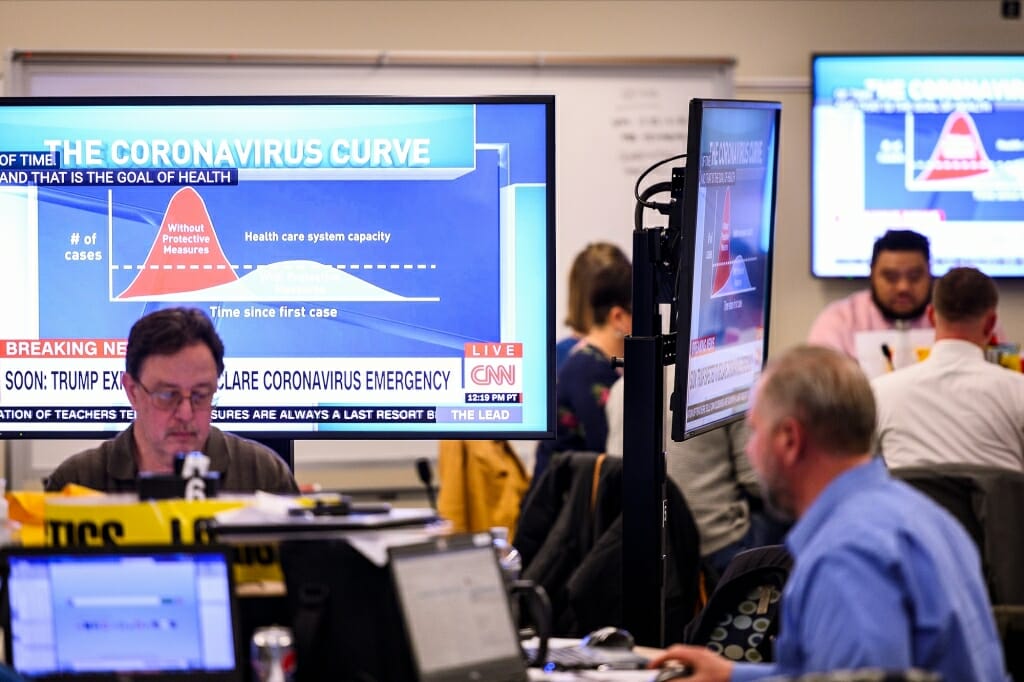
UW–Madison officials spring into action as the pandemic requires urgent planning and decisive action. On March 13, monitors display a CNN news broadcast as staff working in an Emergency Operation Center triage the impact of, and campus response to, rapidly unfolding developments. Photo by: Jeff Miller
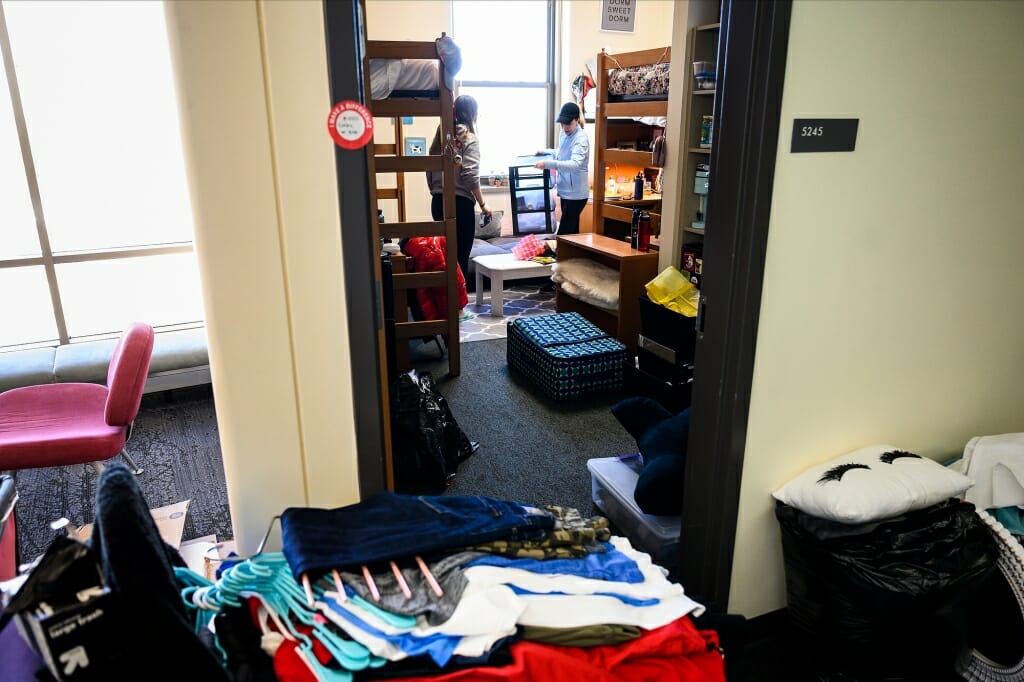
The seriousness of the situation required adaptability on the part of students and their families. Kathy Osteraas of Elgin, Minnesota, helps her daughter, Lauren, move out of Dejope Residence Hall on March 13, just before Spring Break. Due to COVID-19, the university encouraged as many students as possible to move off campus and return to their permanent family residence. Photo by: Jeff Miller
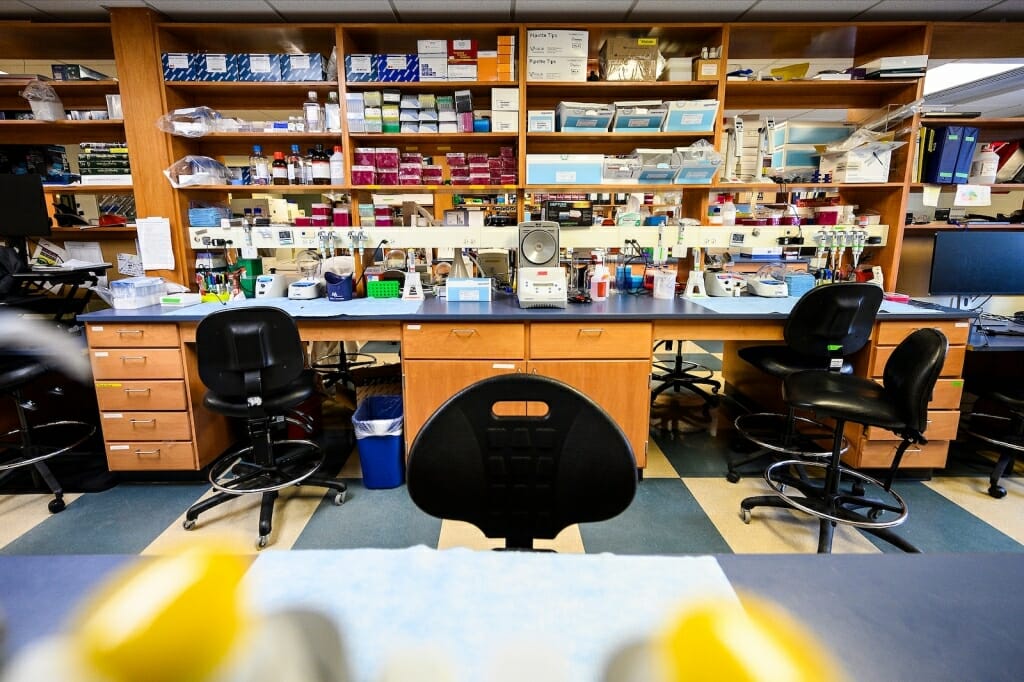
With most laboratory-based research suspended and staff working remotely on data analysis and tasks, this space in the AIDS Vaccine Research Laboratory stands temporarily vacant on March 18. Photo by: Jeff Miller
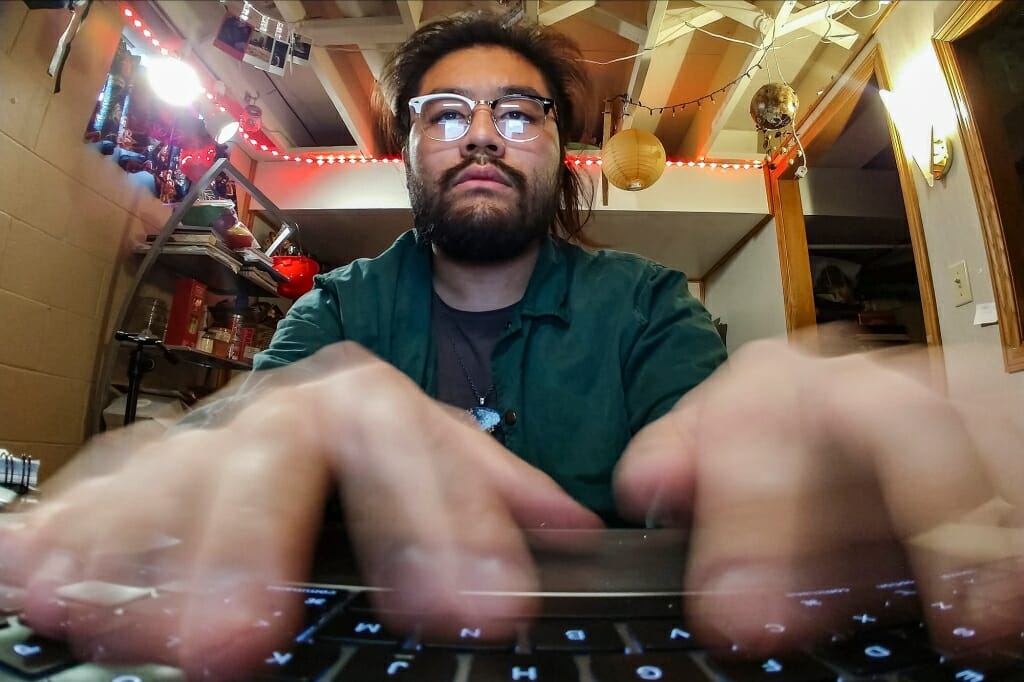
"At the start of the week, I ... divide up my work for the week based on deadlines and my level of fatigue," says University Communications student photographer Brian Huynh as he completes the spring semester from his parents' home in Milwaukee following the suspension of in-person classes. "I'm staring into my laptop for a majority of the day." Photo by: Brian Huynh

But campus operations could not, and did not, grind to a complete halt. Lead cook Jack Tredinnick — one of the workers performing essential functions on campus that continued despite the pandemic — prepares a carryout food order at The Sett in Union South. Photo by: Jeff Miller

If they were a good idea before the pandemic, they were a great idea during. A fleet of University Housing's food-delivery robots wait for remote clearance to cross the intersection of East Campus Mall and West Johnson Street on April 8. The majority of campus was closed, except for essential functions, but some authorized students remained in residence halls. Photo by: Jeff Miller
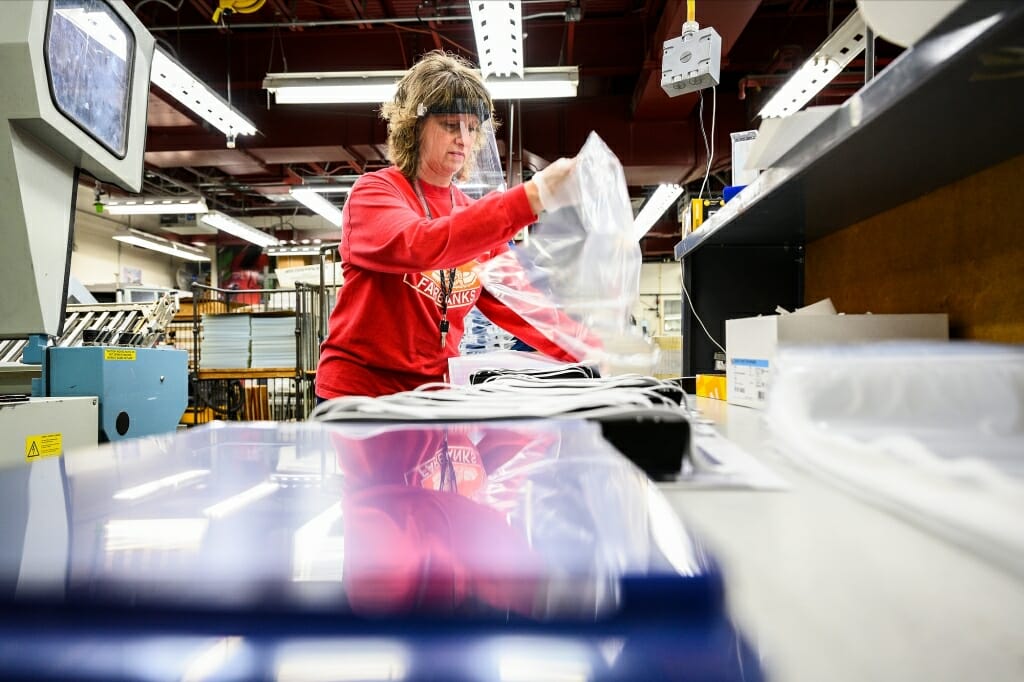
Campus response to the coronavirus takes many forms, with innovative solutions coming from varied sources. Susan Laufenberg fabricates and packages custom-made medical face shields at the Division of Information Technology's Digital Publishing and Printing Services facility on April 2. The equipment is delivered to front-line health workers caring for COVID-19 patients. Photo by: Jeff Miller
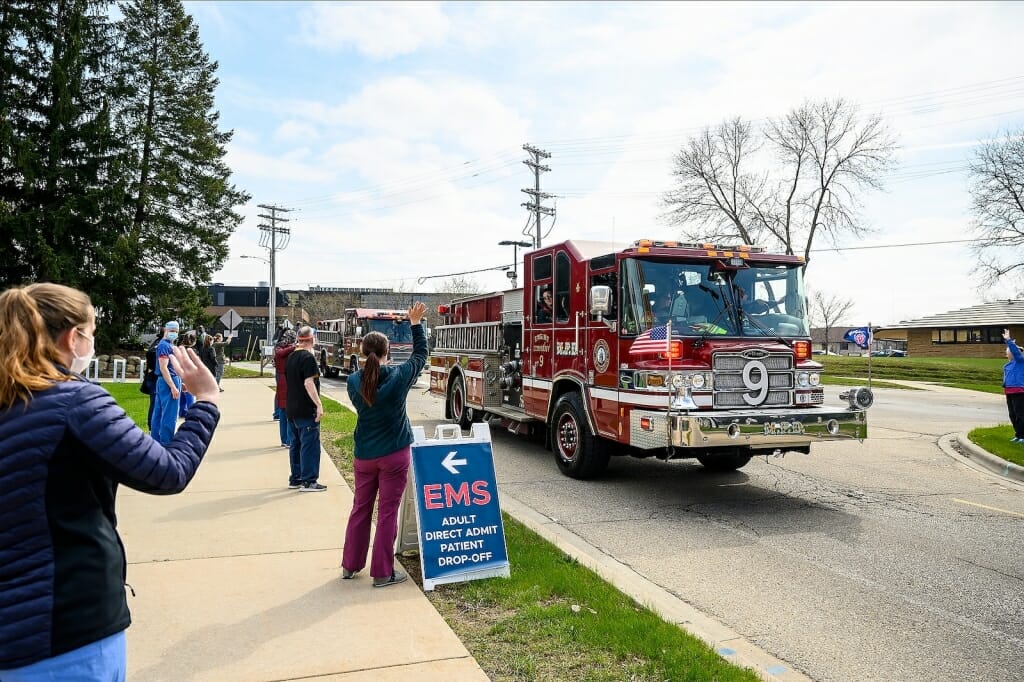
In one example of the community pouring out its gratitude to health care workers who endure long hours and personal risk to fight the virus, fire engines from local Madison stations flash their lights and sound their sirens in honor of medical staff from UW Hospital on April 24. Photo by: Bryce Richter
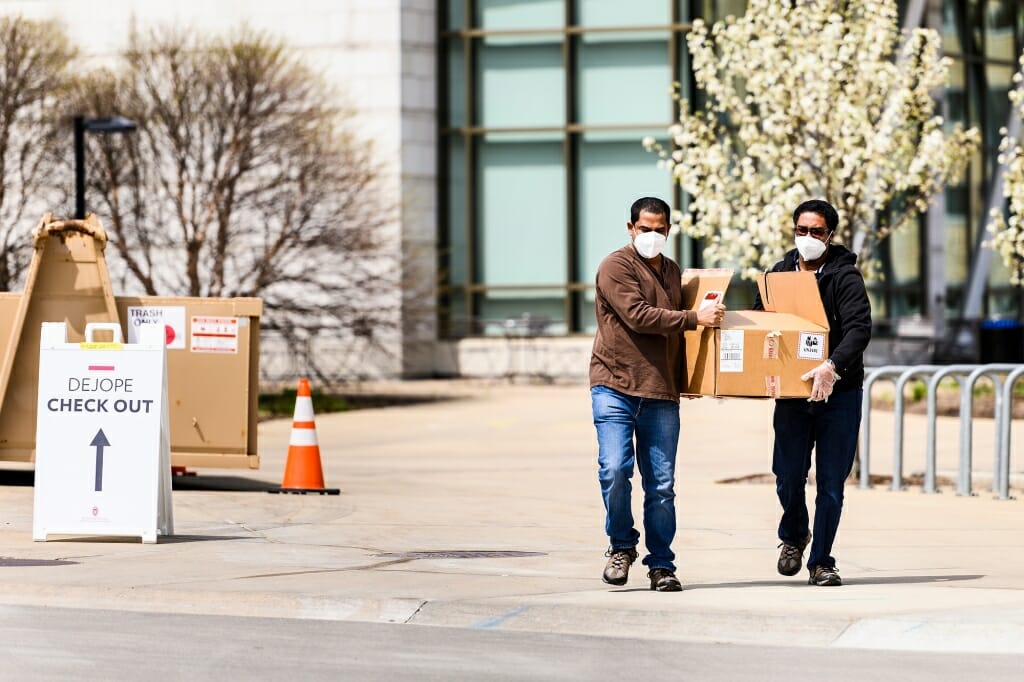
Not knowing when they would be returning to their residence halls, many students left behind all but the essentials when the buildings emptied out in March. They return to claim their belongings — including this student from Dejope Residence Hall, helped by his father — during a phased, socially distanced move-out April 27 to May 7. Photo by: Jeff Miller

In-person spring commencement is canceled in favor of a virtual event, but cherished traditions like caps and gowns do not disappear entirely. Yingzi Zhang, left, a December 2019 graduate with a bachelor's degree in psychology now working on campus, and Qiuhong Li, graduating with a bachelor's degree in computer sciences and statistics, stop for a picture at Alumni Park on May 9. Both are international students from China. Photo by: Jeff Miller
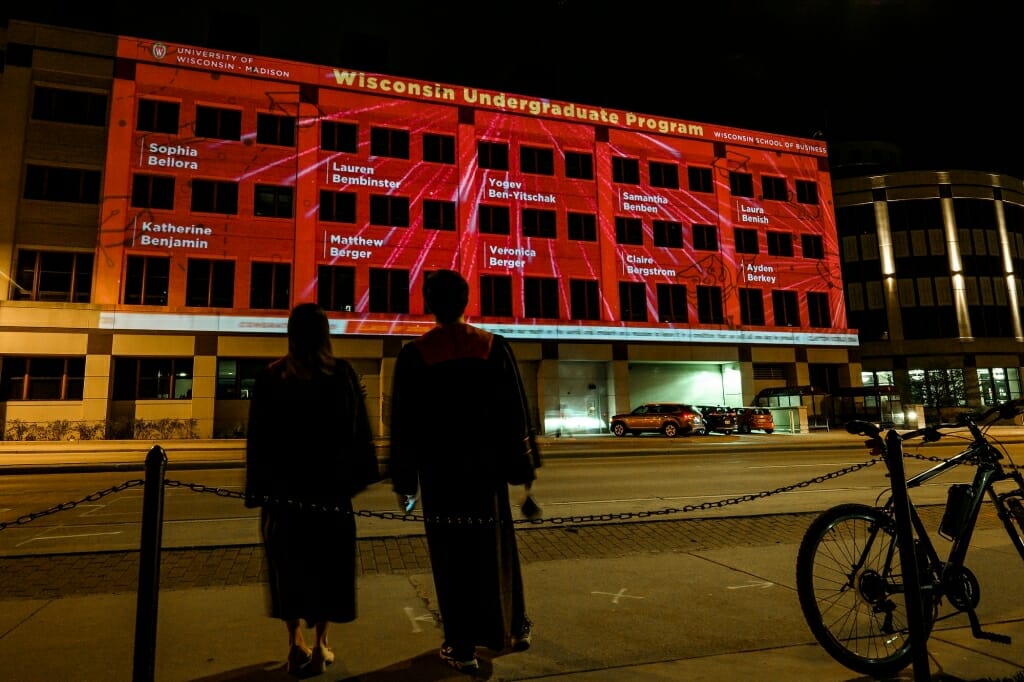
The lack of a traditional commencement ceremony spurs some creative alternatives to honor the Class of 2020. The Wisconsin School of Business projects the names of its grads on the outside of the Badger-red illuminated east facade of Grainger Hall on May 9. Photo by: Bryce Richter
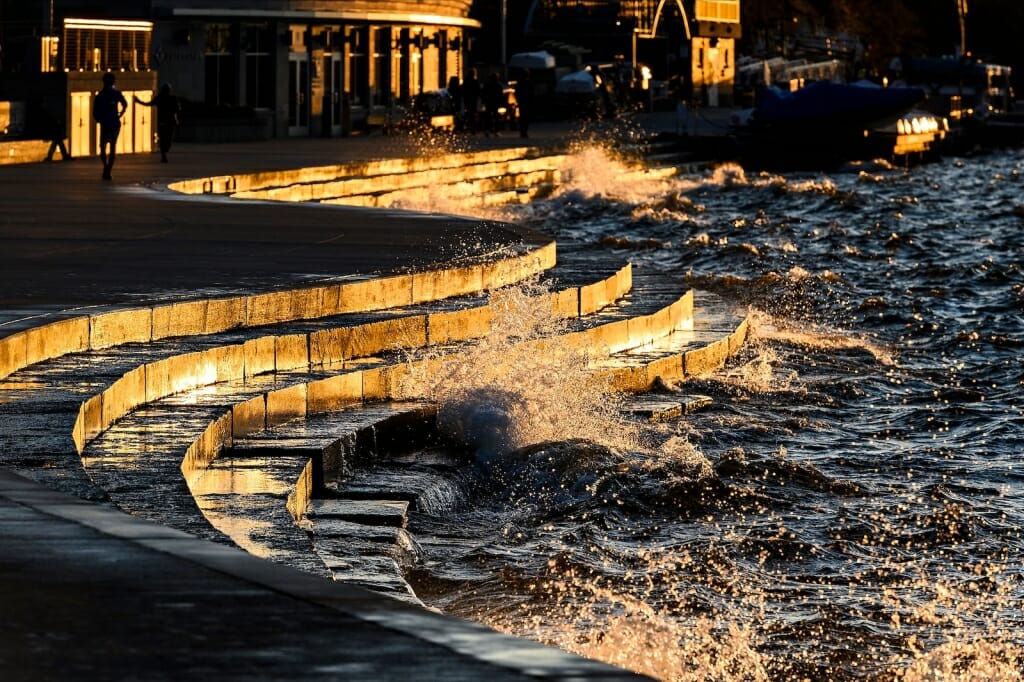
Campus seems to be getting buffeted from all sides, as waves from Lake Mendota crash into the stone shoreline along Alumni Park and the Memorial Union Terrace in early May. Photo by: Jeff Miller
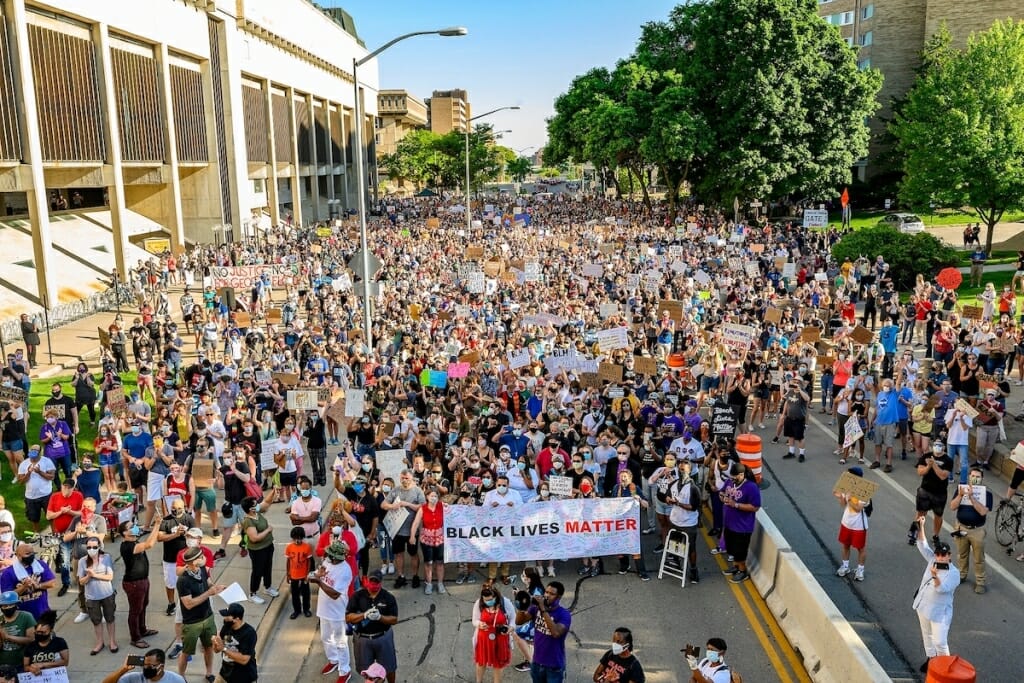
Demonstrators gather near the Mosse Humanities Building on North Park Street to speak out against racism on a march through Library Mall and up State Street on June 7. The group stops every eight minutes and 46 seconds to be reminded of how long a Minneapolis police officer kneeled on the neck of George Floyd, who was killed on May 25. Photo by: Bryce Richter
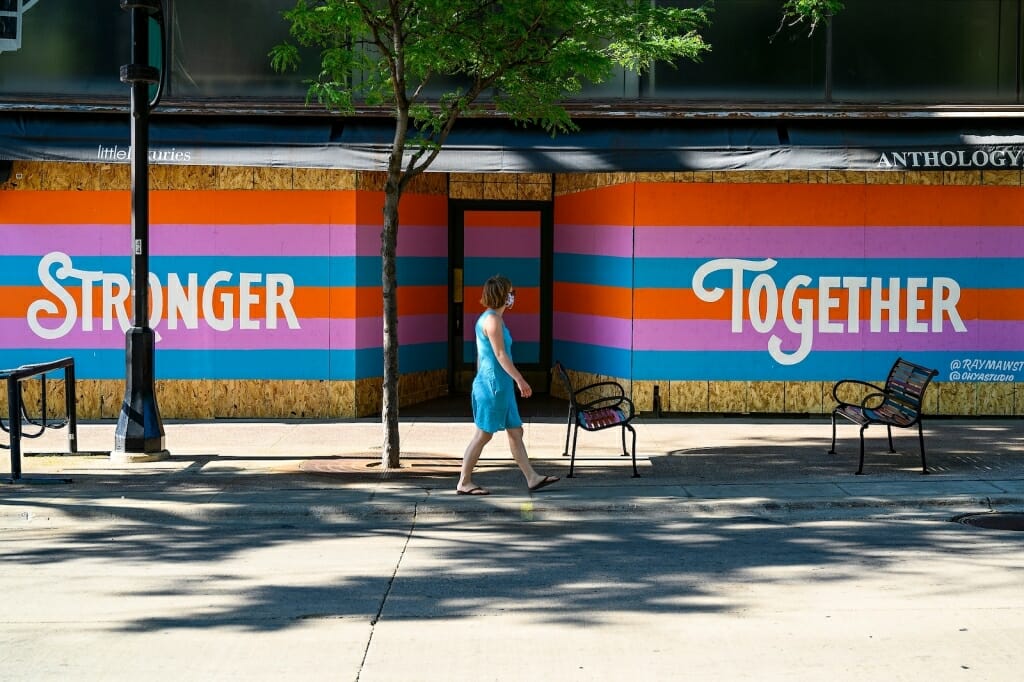
A message supporting the Black Lives Matter movement and bringing awareness to racial injustice is painted on two State Street storefronts on June 5. The mural is one of many expressing similar sentiments that appear downtown following protests in response to the police killing of George Floyd. Photo by: Bryce Richter
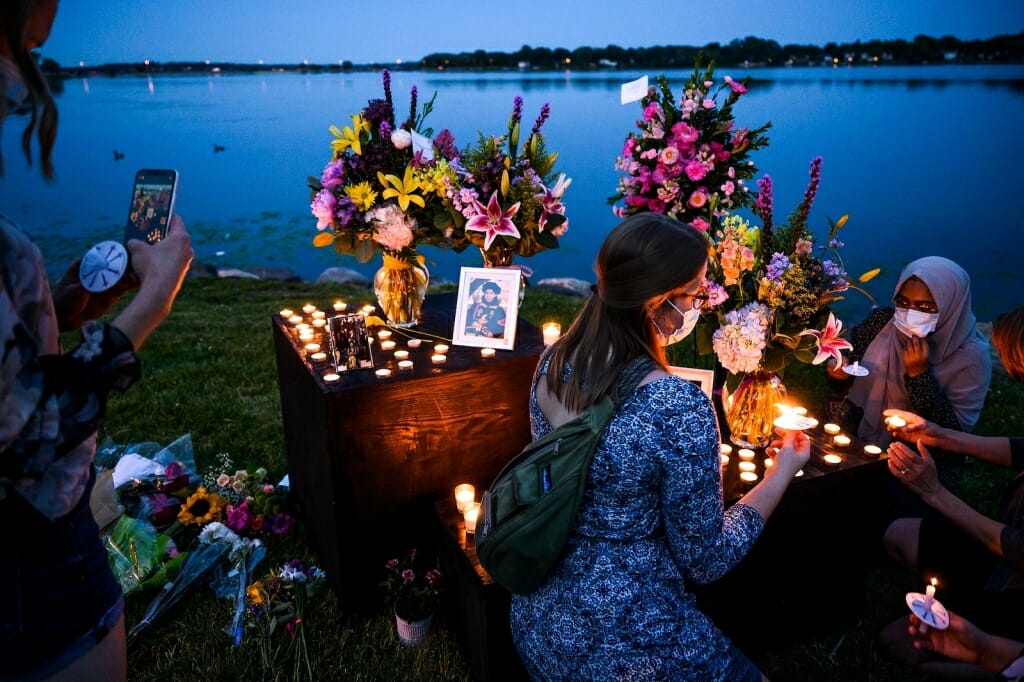
Framed pictures of Bella Sobah, a recent Law School graduate who died unexpectedly at age 25, are displayed during a candlelight vigil organized by the Black Law Students Association at Brittingham Park on June 25. Sobah had just started her career as an assistant Dane County district attorney. Photo by: Jeff Miller
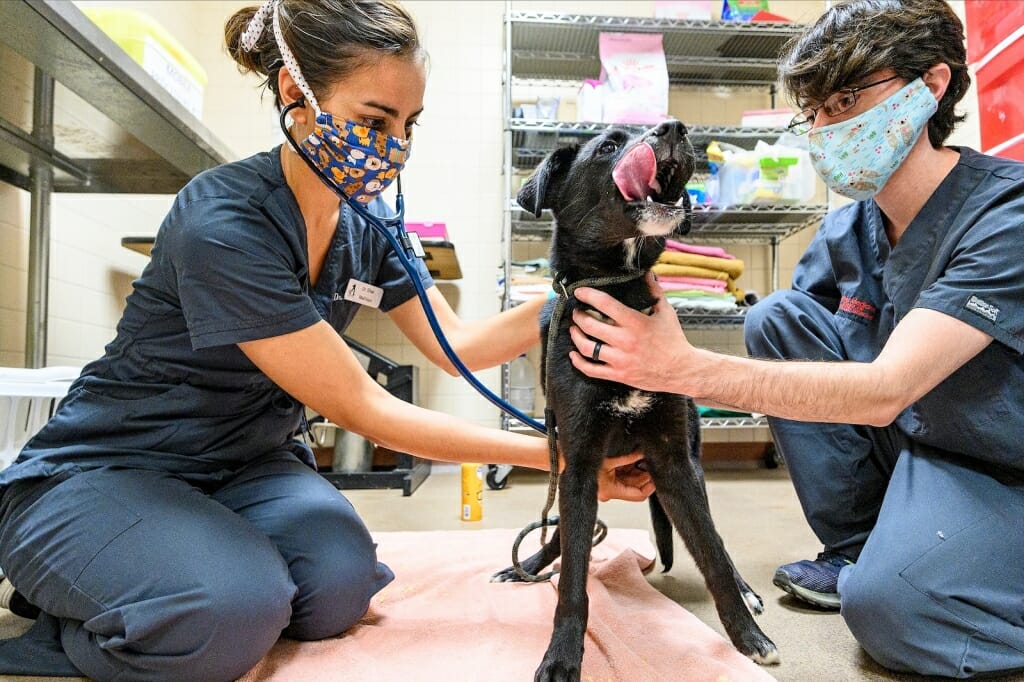
Honey, a terrier mix, receives a health check-up at the Dane County Humane Society performed by Shak Makhijani (left) and Uri Donnett from the Shelter Medicine Program at the School of Veterinary Medicine. The program provides a needed resource for at-risk animals — and for those who care for them each day. Photo by: Bryce Richter
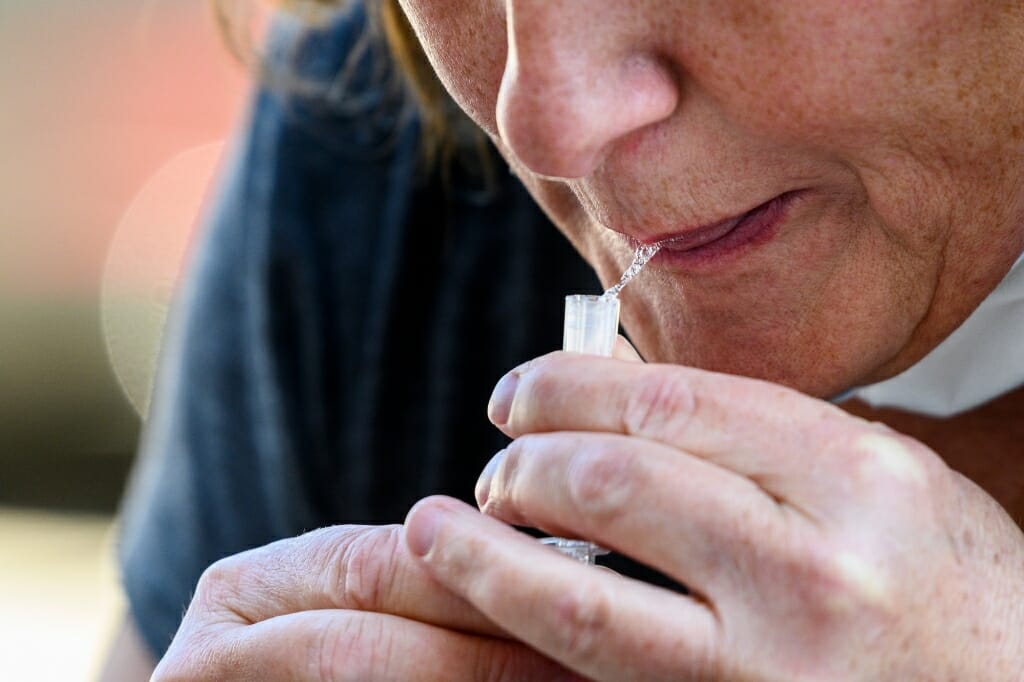
UW researchers become innovators in COVID-testing technology. A volunteer spits into a vial as part of a trial of a new test simple enough to be administered in makeshift lab space outside a UW–Madison campus building on Aug. 4. The potential rapid-result saliva test is being developed by David O'Connor, professor at the UW School of Medicine and Public Health; Tom Friedrich, professor in the UW School of Veterinary Medicine; and partners at UW Hospital and Clinics. Photo by: Jeff Miller

Partnerships enable progress as the university builds capacity to enable widespread testing. Student Megan Skoyen dispenses viral transport media for kits being created at the Wisconsin Veterinary Diagnostic Lab on July 2. WVDL is working with the Wisconsin State Lab of Hygiene, University Health Services, the School of Medicine and Public Health, and others on campus to set up COVID-19 testing for students, faculty and staff. Photo by: Bryce Richter
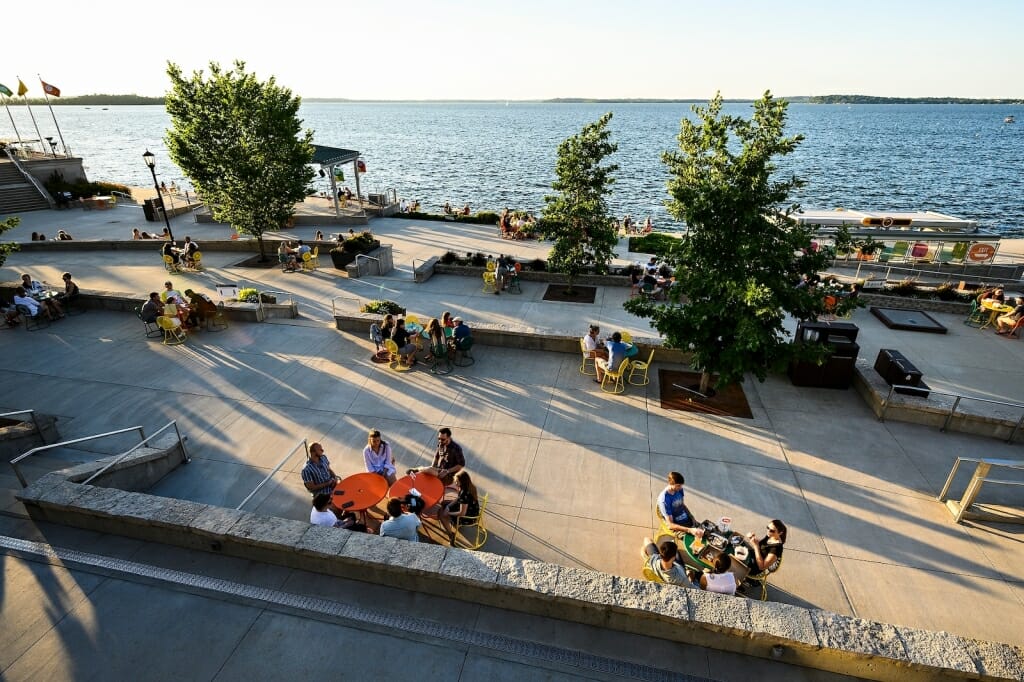
Slowly and safely, familiar scenes begin to return in modified form. Patrons enjoy physically distanced, reserved-table seating with food and drink service at the Memorial Union Terrace on July 10. Masks and face coverings are required upon entry, while receiving service and while exiting. Photo by: Jeff Miller
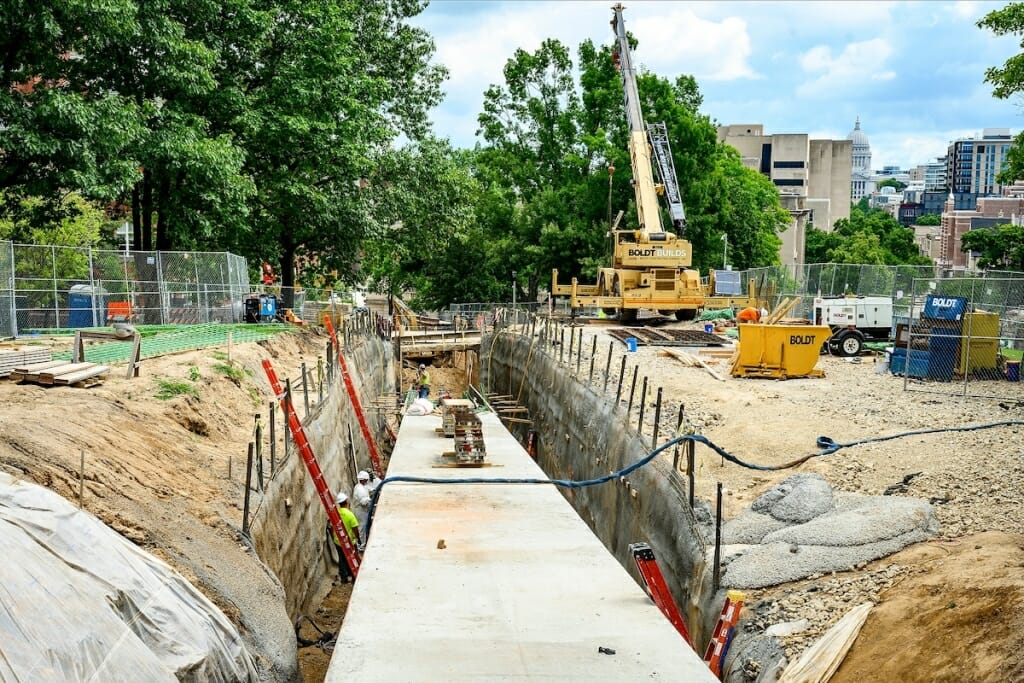
Another familiar campus scene — construction — never really did disappear. With fewer people on campus than usual on this July day, underground utility work on Bascom Hill presents less of an inconvenience than it would during a more typical summer break. Photo by: Bryce Richter

No problem with physical distancing up here, as a worker balances on the structure of the new Chemistry Building addition under construction on July 1. Photo by: Bryce Richter
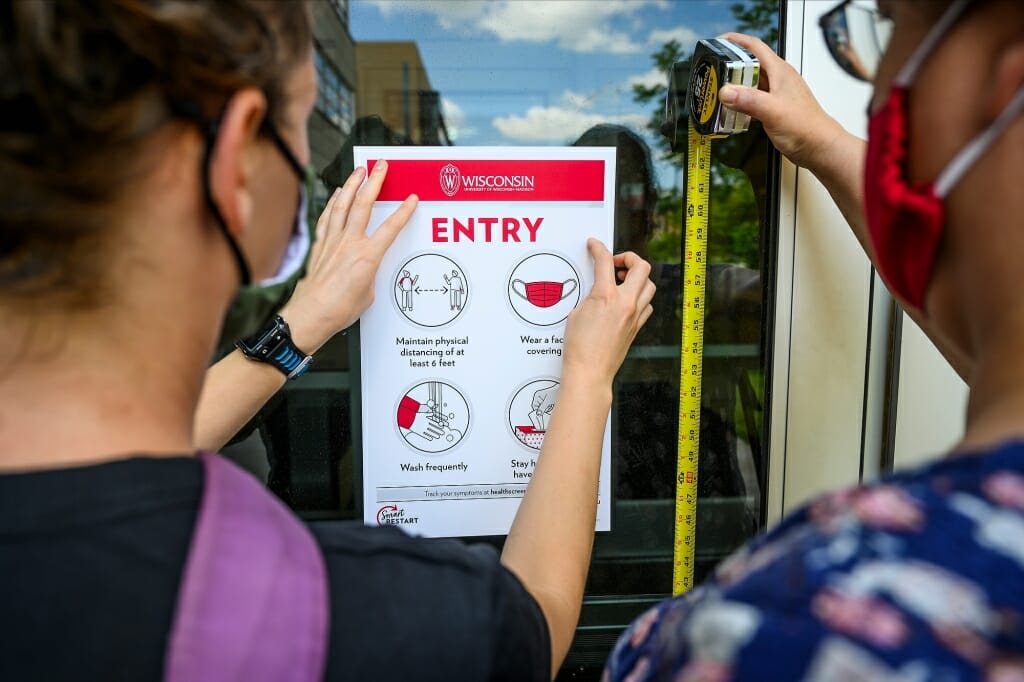
Thorough planning gets underway for a return to in-person classes for the fall semester. Members of a facilities planning committee meet to test installation of new signage at the Health Sciences Learning Center. Photo by: Jeff Miller
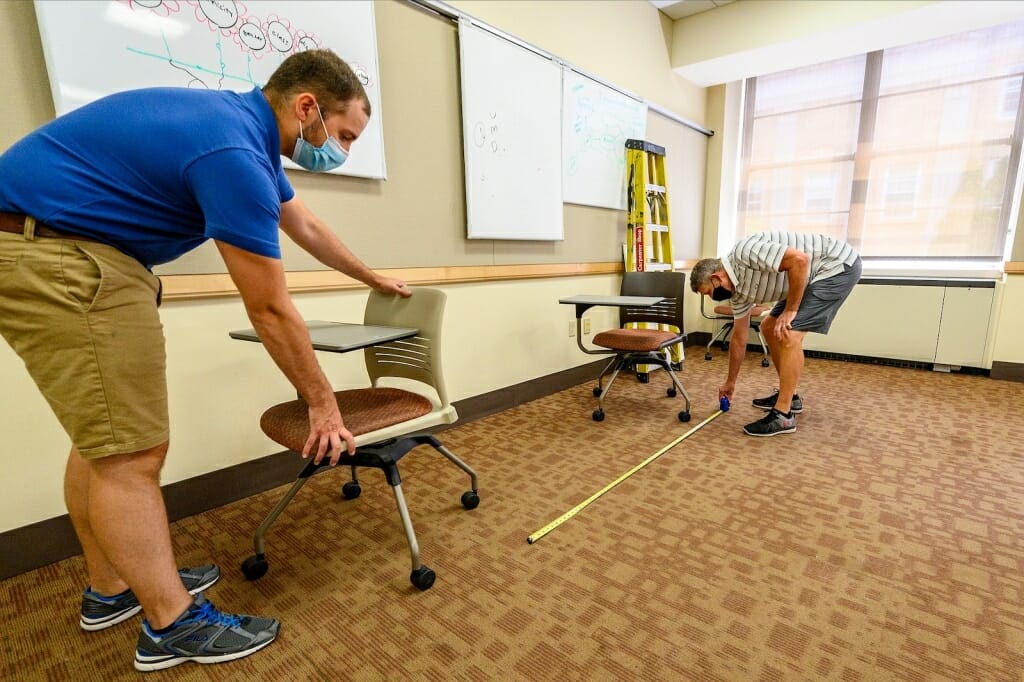
Health considerations dictate strict criteria for the reconfiguration of classrooms. Abe Schrump (left) and Tom Wise of Facilities Planning and Management's Space Management Department make precise measurements to ensure safe physical distancing when students return to Ingraham Hall. Photo by: Bryce Richter
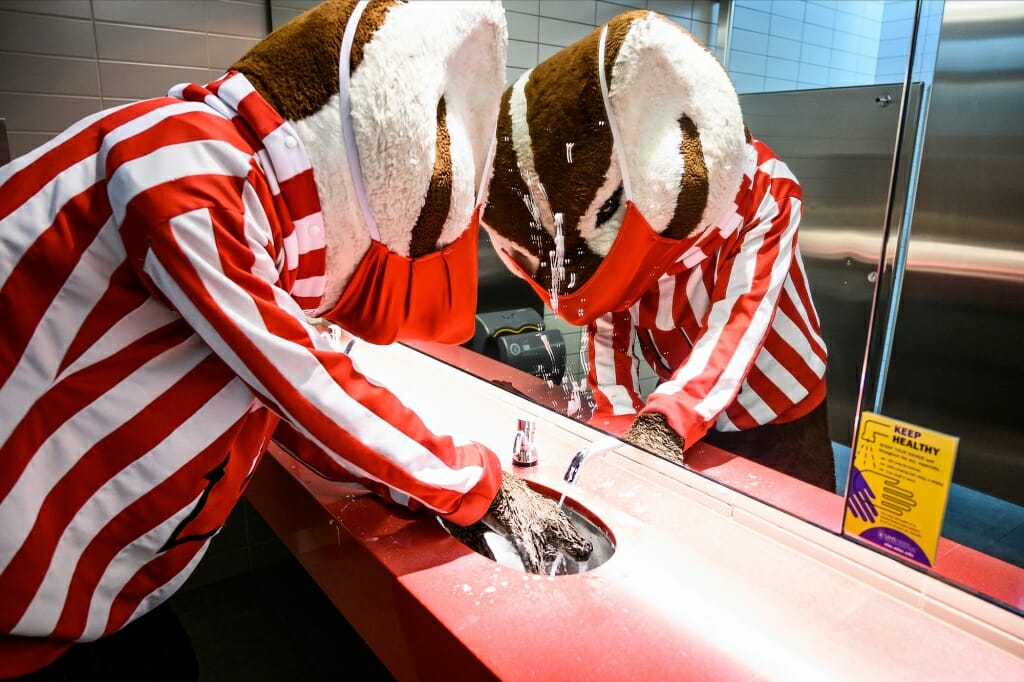
Setting an example with clean paws and a face covering, Bucky Badger — scrubbing up in the Discovery Building — is enlisted in campus messaging to promote safe hygiene practices against the spread of COVID-19 as students prepare to return for classes. Photo by: Jeff Miller
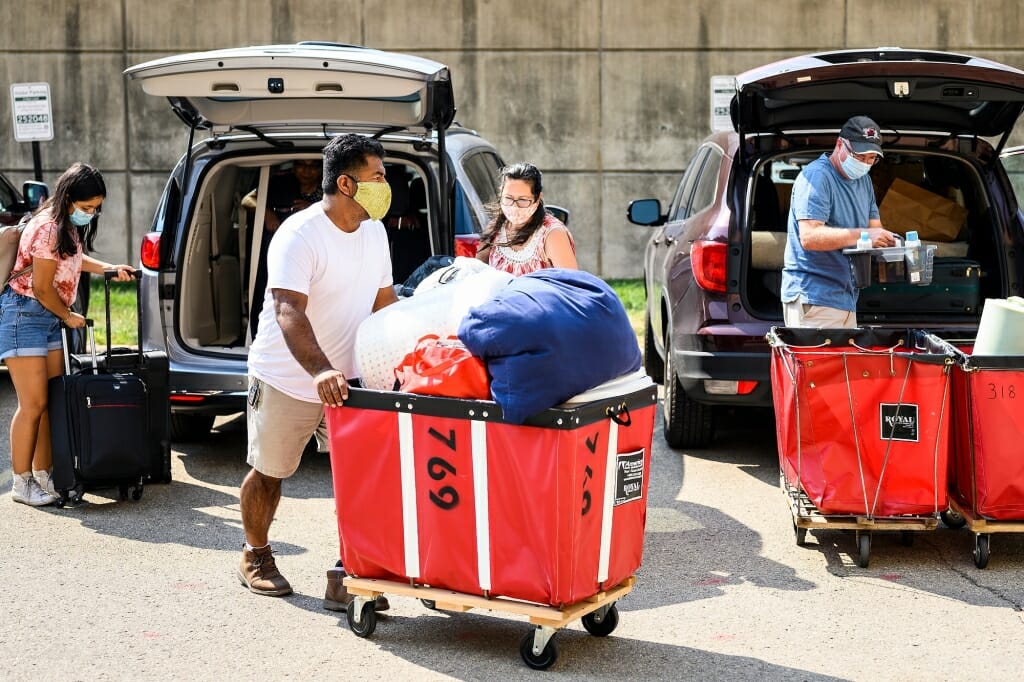
It's back to business — not as usual, but as modified by public health considerations — on Aug. 26 for these families moving their students into Ogg Residence Hall. Photo by: Jeff Miller
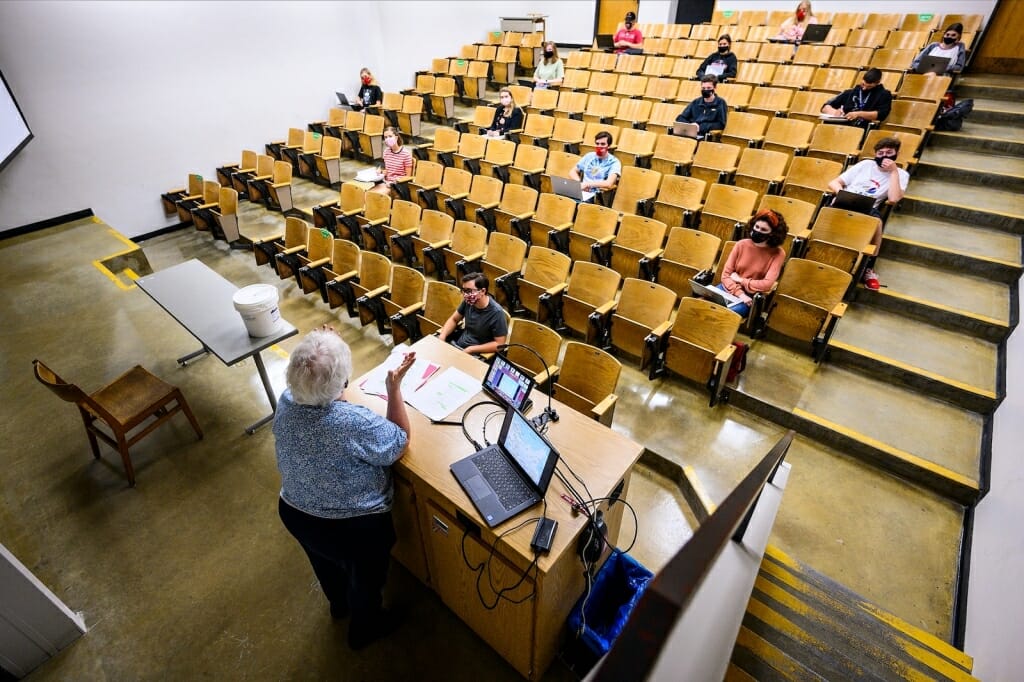
This is the new normal on the first day of classes as the fall semester gets underway. Students wear face coverings and sit far apart in a class taught by law Professor Kathryn Hendley in the Mosse Humanities Building on Sept. 2. Photo by: Jeff Miller
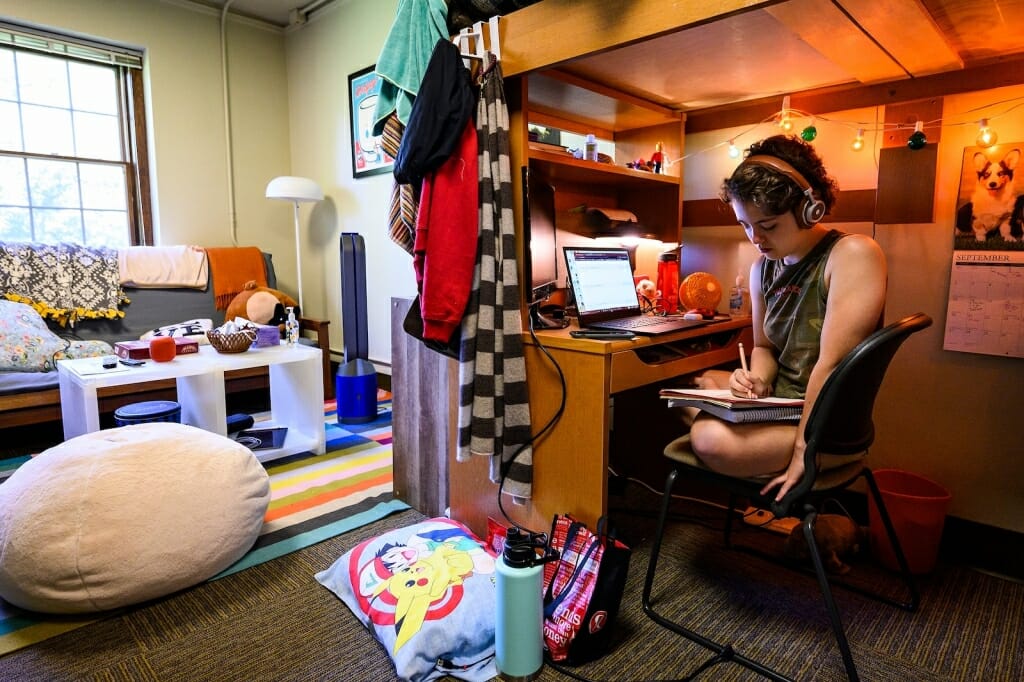
Although in-person classes have resumed, some courses are conducted partly or entirely online. Bella Rosenberg, a first-year student from Chicago, takes notes for a virtual calculus class in her room at Elizabeth Waters Residence Hall on Sept. 2. Photo by: Jeff Miller
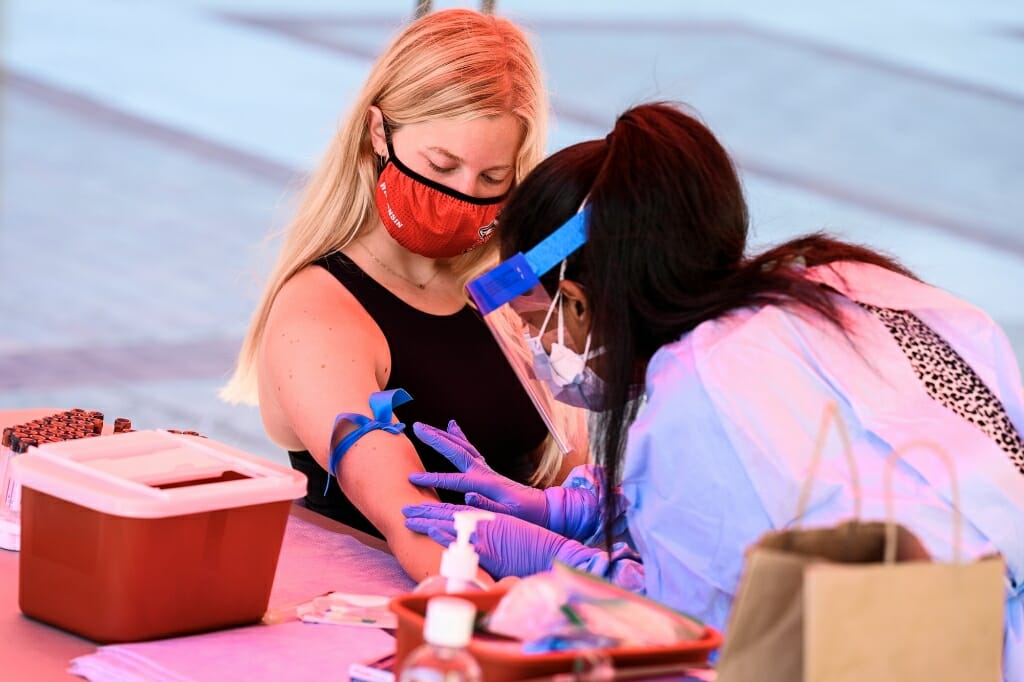
Federal, state and campus health authorities partner in an epidemiological study to better understand how coronavirus is spread among the college-age population. First-year student Jayden Jones sits for a blood draw outside Ogg Residence Hall. Photo by: Jeff Miller
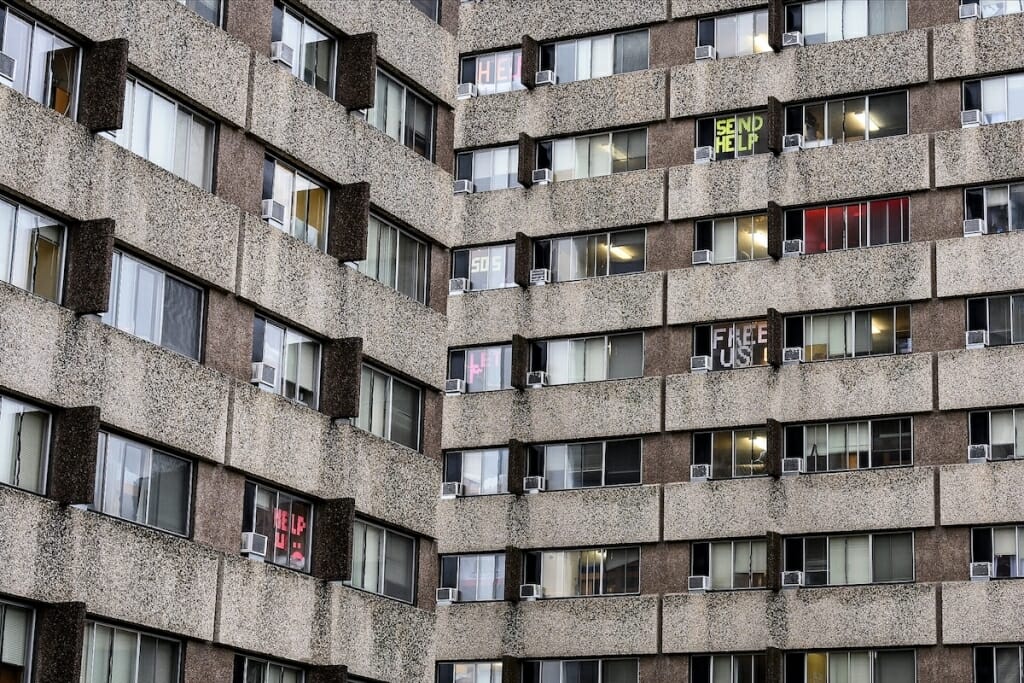
An alarming spike in positive test results necessitates the quarantining of Sellery and Witte residence halls on Sept. 19, 2020. But a new study says it appears the quarantine, and other measures, likely helped contain the outbreak. Photo by: Jeff Miller
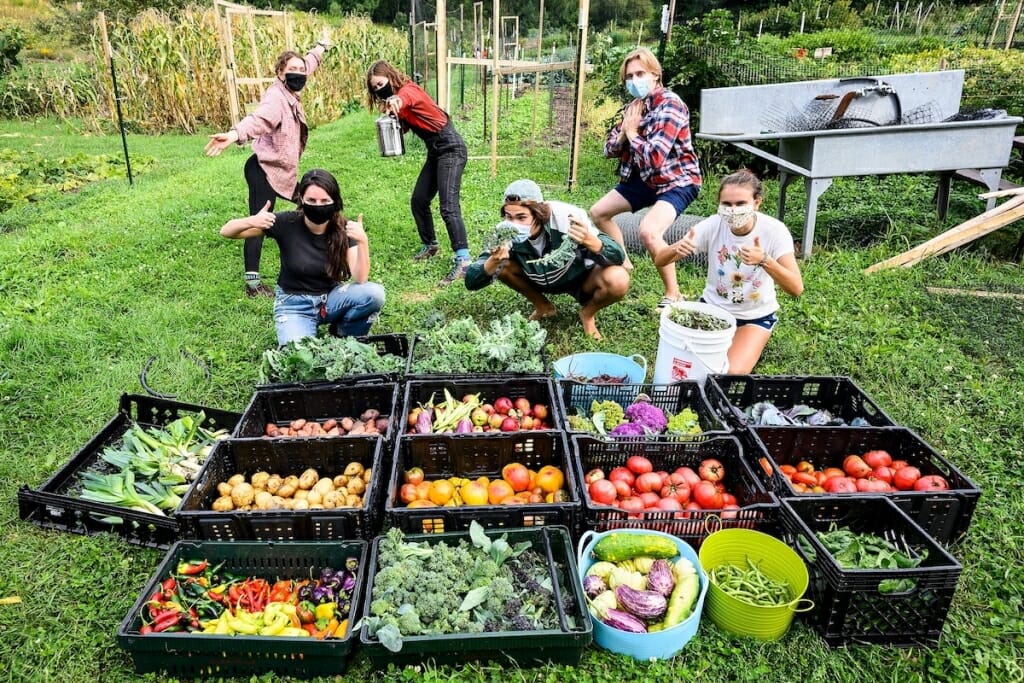
Good things come from the earth, even during a pandemic. Clockwise from upper left, Jenny Zinniker, Sophia Webber, Will Hofkamp, Maggie Marshall, Christopher Hastings and Molly DeVore with F.H. King Students for Sustainable Agriculture pose on Sept. 13 after harvesting more than 300 pounds of produce from their farm plot at Eagle Heights Community Garden. Photo by: Jeff Miller

A year like no other spawns a football season like no other. The Badgers takes on Illinois before an otherwise empty Camp Randall Stadium on Oct. 23, with only essential staff and no fans allowed. UW won, 45-7. Photo by: Jeff Miller
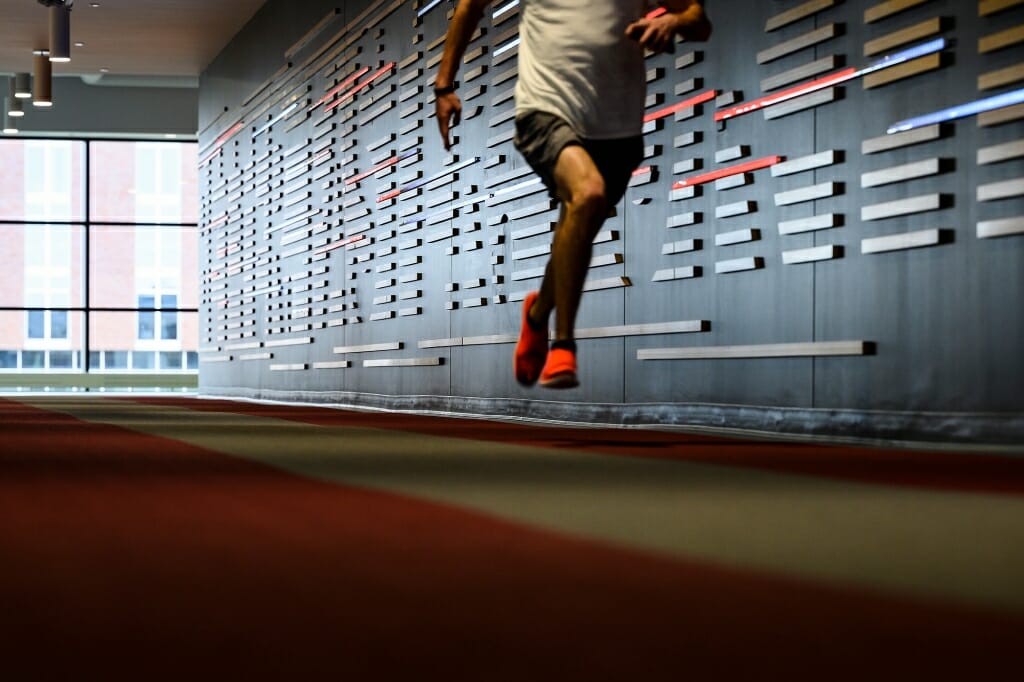
Wellness is a priority for this runner, who finds a new campus venue to stay fit on Oct. 14. Upon opening, the Nicholas Recreation Center, known as "The Nick," operates at 25 percent capacity with face coverings and physical distancing required. Photo by: Jeff Miller
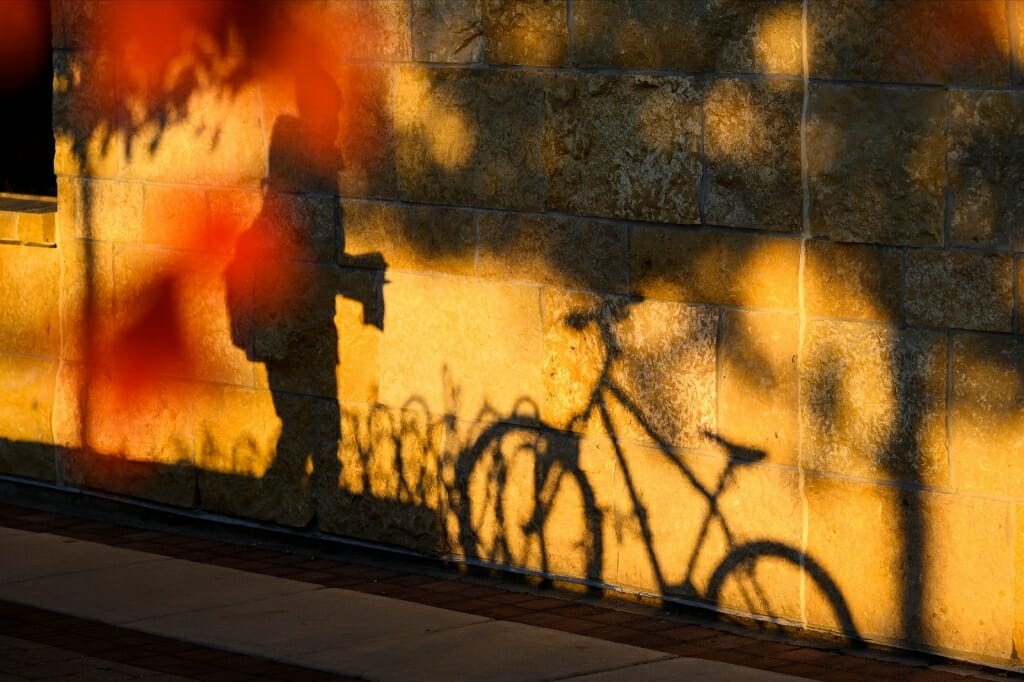
Dazzling fall colors (whether sunlit or silhouetted), always a comforting seasonal sight on campus, are especially welcome this year. Late afternoon shadows of a parked bike and a passing pedestrian are cast upon the stone exterior of the Gordon Dining and Event Center at sunset on Oct. 27. Photo by: Jeff Miller
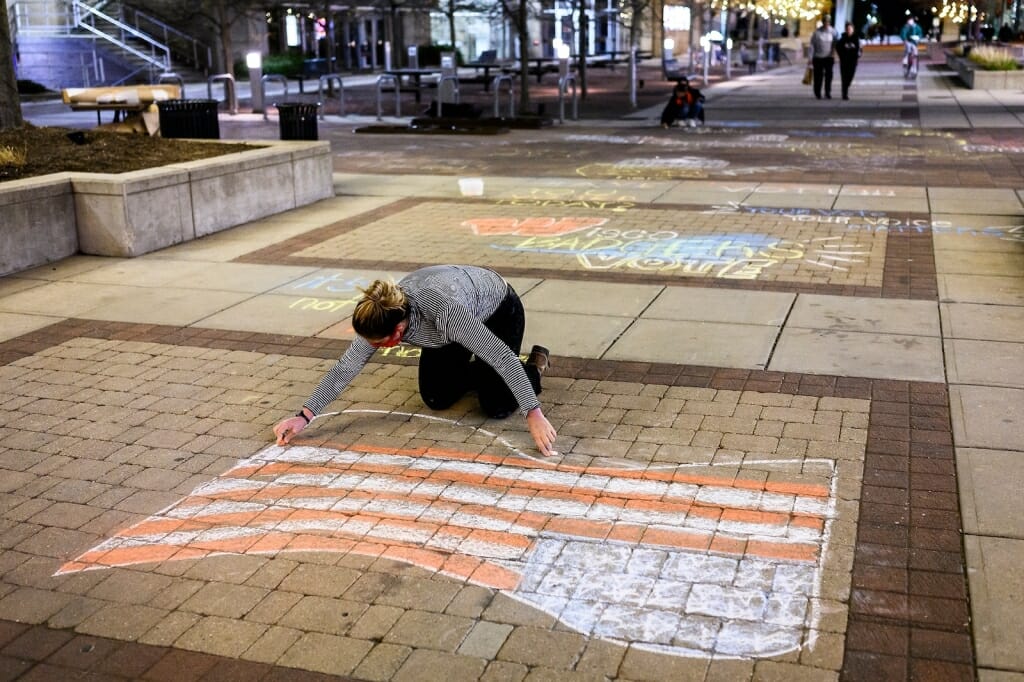
After an intensive campaign for early voting on campus, a chalk muralist reminds students on Nov. 2 that tomorrow is Election Day. Photo by: Jeff Miller
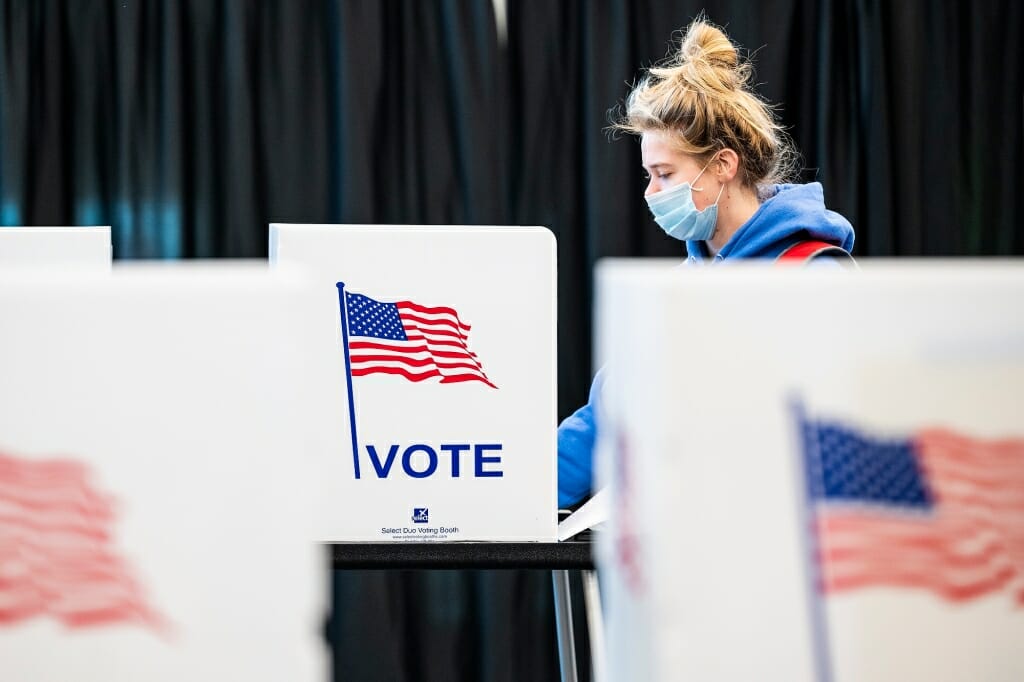
Voters wearing face coverings and maintaining their physical distance cast their ballots at the Nick on Nov. 3. Early voting for the Feb. 16 primary will be at Memorial Union from Feb. 8 to 12. Photo by: Bryce Richter
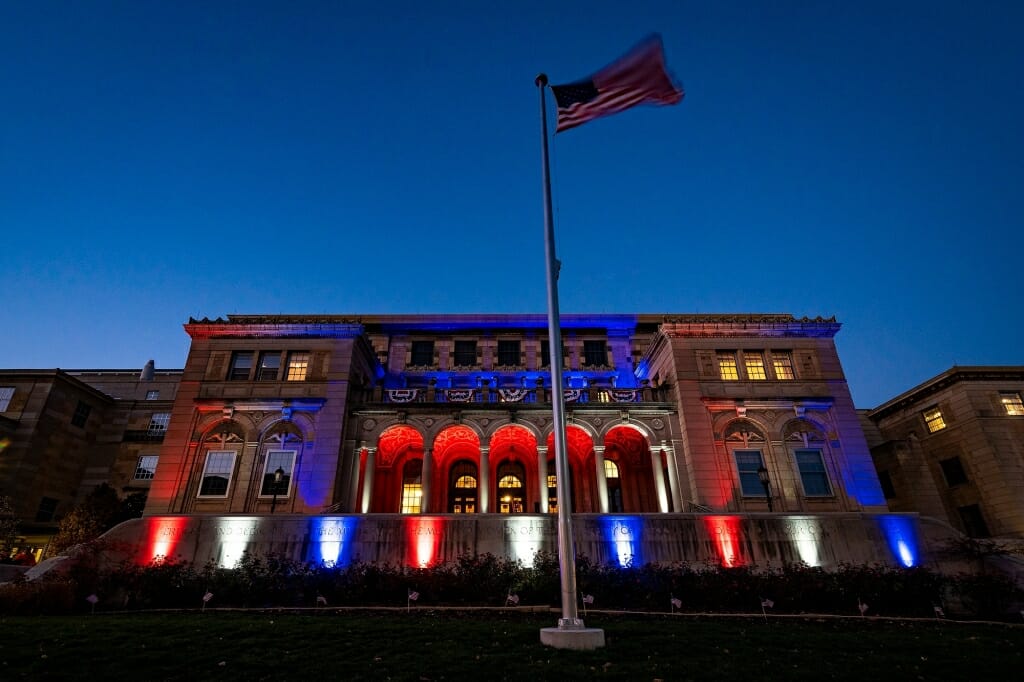
"Erected and dedicated to the memory of the men and women of the University of Wisconsin who served in our country's wars," as the inscription on its entrance proclaims, the Memorial Union is illuminated in red, white and blue lights in observance of Veterans Day on Nov. 11. Photo by: Bryce Richter
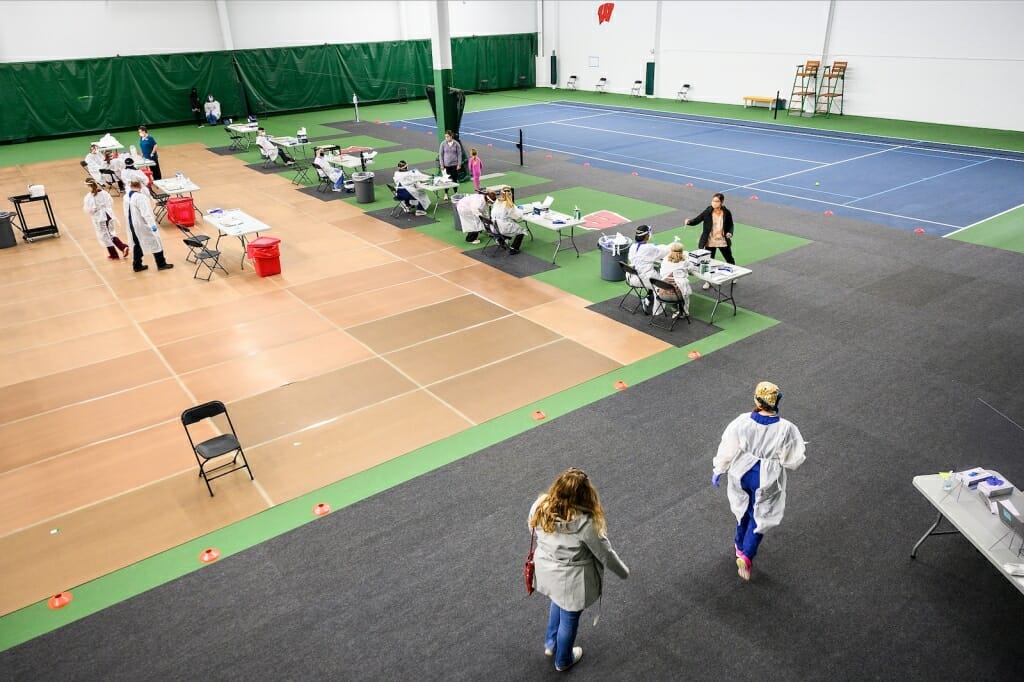
The UW ramps up testing availability for the benefit of not only campus but the surrounding community. Members of the public participate in COVID-19 surge testing at Nielsen Tennis Stadium on Nov. 12. The rapid antigen testing can deliver results in as little as 15 minutes. Photo by: Jeff Miller
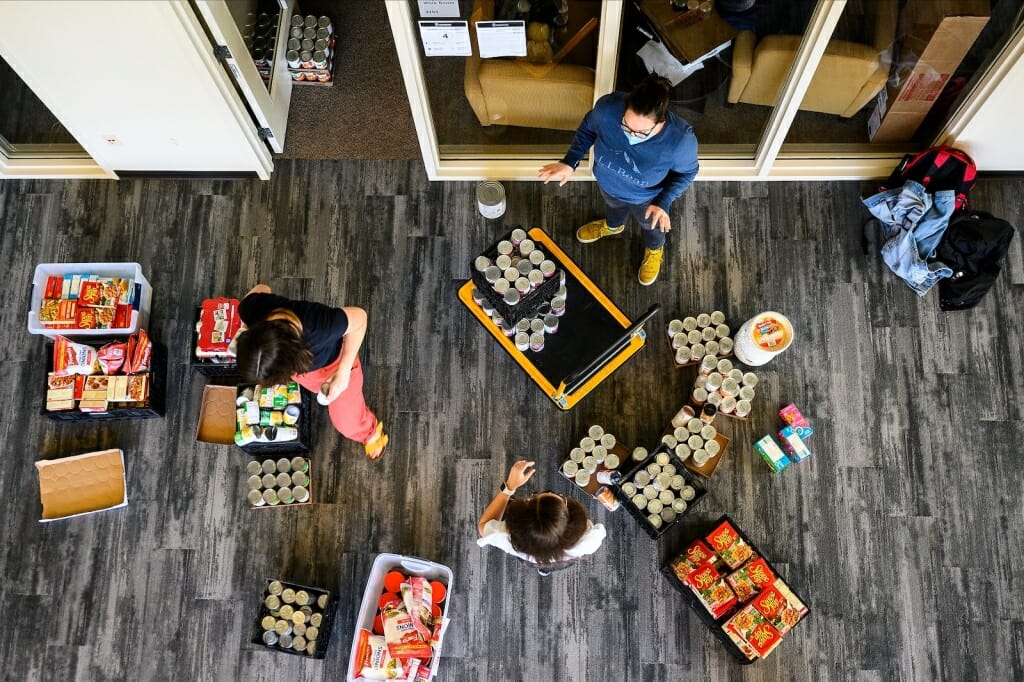
Thanksgiving may be bittersweet for many people unable to share it with loved ones, but more than 100 students are better able to celebrate with donations of Thanksgiving dinner ingredients from the Open Seat Food Pantry, distributed at the Student Activity Center on Nov. 21. Photo by: Jeff Miller
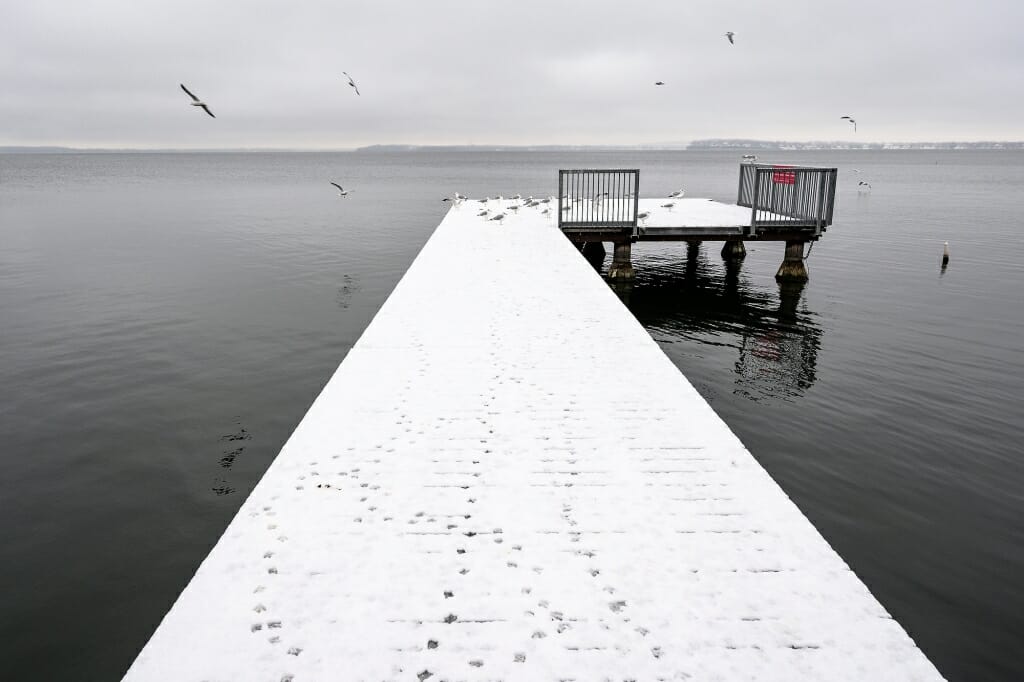
A blanket of snow provides a picturesque end to a difficult year. Following the first snowfall of the season, a flock of seagulls perch on the Goodspeed Family Pier on Lake Mendota on Nov. 24. Campus was becoming quieter as students departed for the holiday, with the remainder of fall semester classes being conducted remotely. Photo by: Jeff Miller
Tags: recent sightings



